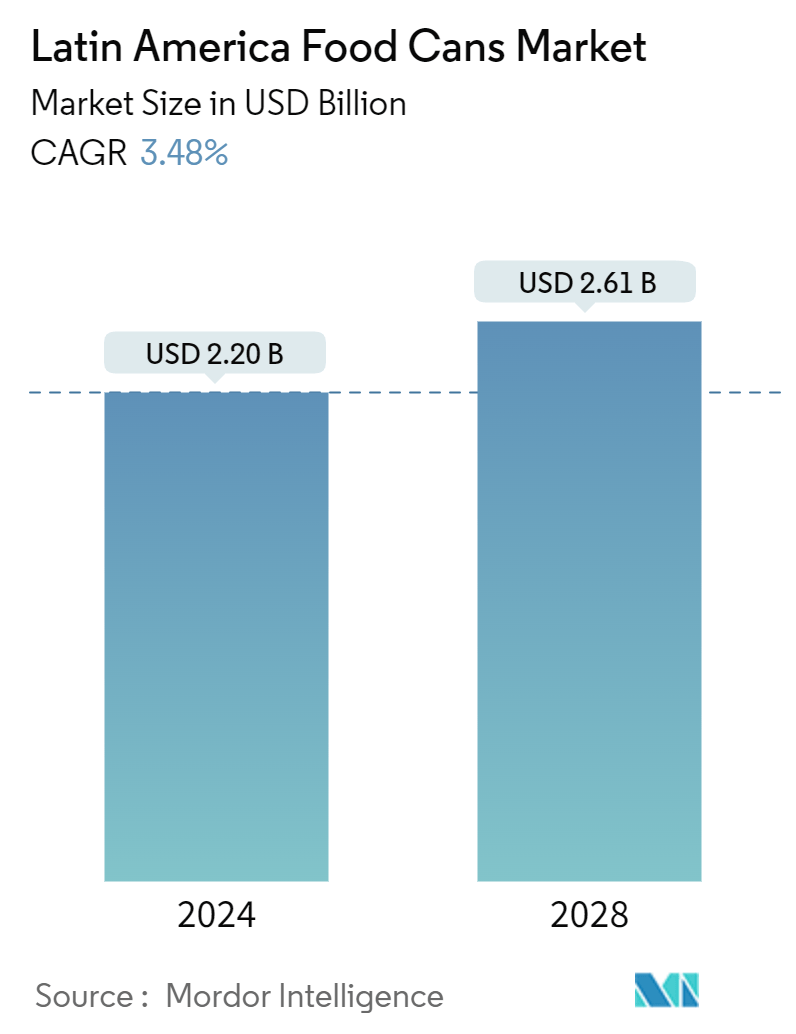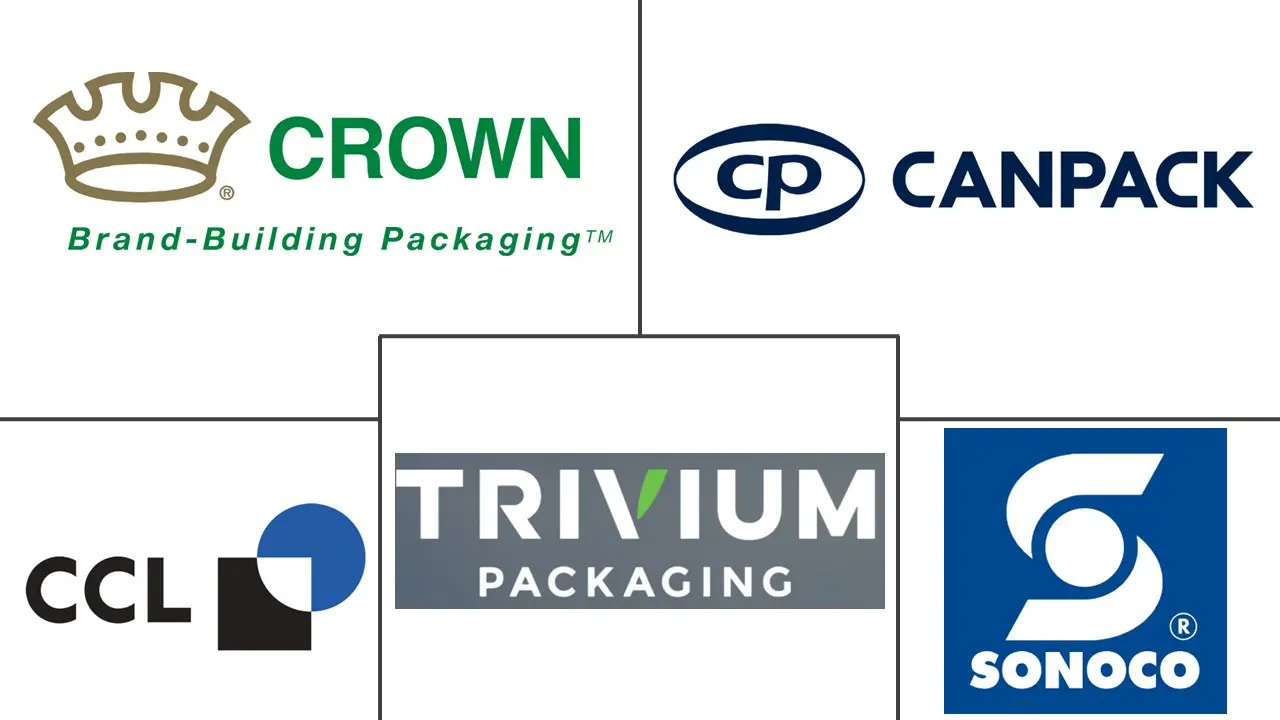Market Size of Latin America Food Cans Industry

| Study Period | 2019 - 2029 |
| Base Year For Estimation | 2023 |
| Market Size (2024) | USD 2.20 Billion |
| Market Size (2029) | USD 2.61 Billion |
| CAGR (2024 - 2028) | 3.48 % |
| Market Concentration | Medium |
Major Players
*Disclaimer: Major Players sorted in no particular order |
Latin America Food Cans Market Analysis
The Latin America Food Cans Market size is estimated at USD 2.20 billion in 2024, and is expected to reach USD 2.61 billion by 2029, growing at a CAGR of 3.48% during the forecast period (2024-2029).
Food cans are widely used as they are corrosion-resistant and have an extended shelf life. Its benefits include stiffness, stability, and strong barrier qualities.
- The rising trend of a busy life, especially among the younger population, has increased the market significantly. Increasing workload and time restrictions have led to adopting ready-to-eat packed and canned food to save time and energy.
- Packaging for canned food made of steel or aluminum shields the product from elements like heat and pollution, preventing spoilage. This packaging provides more security and a longer product shelf life. Perishable food items can be inexpensively preserved with slight flavor alteration via canning. Consequently, the expanding horticultural and seafood processing industries significantly demand this packaging.
- The Latin American Steel Association (Alacero) forecasts the sector's growth outlook in Latin America for late 2022 and early 2023 to be moderate, given the backdrop of global inflation and contractionary monetary policy. However, according to data presented by the Latin American Steel Association (Alacero) during the two-day summit in Brazil in 2023, the consumption of rolled steel was expected to increase by 2.4% compared to the previous year.
- In July 2023, Sacmi Imola S.C. participated in the LatamCan 2023 exhibition to give a presentation on its next-generation AI-based vision system for the can-making industry. The company launched the AI tool in the metal packaging industry. This tool's technical interface is user-friendly and is mainly used to inspect metal packaging defects. Such technological innovations in the market are expected to help companies manufacture defectless food cans.
- Latin America imports metals from other countries, such as China, and imports continue to threaten Latin American trade. Products continue to enter the region at prices below the market from countries with non-market economies subsidizing steel production. Therefore, fluctuations in metal costs due to trade scenarios or economic conditions may impact the market studied.
Latin America Food Cans Industry Segmentation
Food cans are mainly used to store various types of food and are available in various sizes based on the requirement. The cans can be opened by cutting the end open, or a few cans can have removable covers.
The Latin American food cans market is segmented by material type (aluminum cans and steel cans), application (ready meals, powder products, fish and seafood, fruits and vegetables, processed food, pet food, and other applications), and country (Brazil, Mexico, Argentina, and Rest of Latin America). The market sizes and forecasts are provided in terms of value (USD) for all the above segments.
| By Material Type | |
| Aluminium Cans | |
| Steel Cans |
| By Application | |
| Ready Meals | |
| Powder Products | |
| Fish and Seafood | |
| Fruits and Vegetables | |
| Processed Food | |
| Pet Food | |
| Other Applications |
| By Country*** | |
| Brazil | |
| Mexico | |
| Argentina |
Latin America Food Cans Market Size Summary
The Latin America food cans market is experiencing a steady expansion, driven by the increasing demand for convenient and long-lasting food packaging solutions. The market benefits from the corrosion-resistant properties and extended shelf life of food cans, which are primarily made from steel and aluminum. These materials provide robust protection against environmental factors, ensuring the preservation of food quality. The growing trend of busy lifestyles, particularly among younger consumers, has led to a surge in the consumption of ready-to-eat and canned foods, further propelling market growth. The seafood and horticultural processing industries are significant contributors to this demand, as canning offers an economical way to preserve perishable items with minimal flavor alteration. Despite challenges such as global inflation and trade fluctuations, the market is poised for moderate growth, supported by technological advancements and strategic industry collaborations.
The market landscape is characterized by a semi-consolidated structure with key players like Crown Holdings Inc., Canpack Group, and Sonoco Products Company leading the charge. These companies are actively investing in innovation and strategic partnerships to enhance their market presence. The increasing preference for aluminum cans, due to their lightweight and recyclable nature, is a notable trend, with Brazil emerging as a significant player in aluminum can recycling. The Brazilian retail sector's expansion, coupled with urbanization, is expected to further drive the demand for metal cans. Additionally, government policies aimed at reducing import duties on essential goods are likely to benefit the industry. As the demand for frozen and processed foods rises, the market for food cans in Latin America is set to grow, supported by the region's evolving consumer preferences and economic conditions.
Latin America Food Cans Market Size - Table of Contents
-
1. MARKET INSIGHTS
-
1.1 Market Overview
-
1.2 Industry Value Chain Analysis
-
1.3 Industry Attractiveness - Porter's Five Forces Analysis
-
1.3.1 Bargaining Power of Suppliers
-
1.3.2 Bargaining Power of Buyers
-
1.3.3 Threat of New Entrants
-
1.3.4 Threat of Substitute Products
-
1.3.5 Intensity of Competitive Rivalry
-
-
-
2. MARKET SEGMENTATION
-
2.1 By Material Type
-
2.1.1 Aluminium Cans
-
2.1.2 Steel Cans
-
-
2.2 By Application
-
2.2.1 Ready Meals
-
2.2.2 Powder Products
-
2.2.3 Fish and Seafood
-
2.2.4 Fruits and Vegetables
-
2.2.5 Processed Food
-
2.2.6 Pet Food
-
2.2.7 Other Applications
-
-
2.3 By Country***
-
2.3.1 Brazil
-
2.3.2 Mexico
-
2.3.3 Argentina
-
-
Latin America Food Cans Market Size FAQs
How big is the Latin America Food Cans Market?
The Latin America Food Cans Market size is expected to reach USD 2.20 billion in 2024 and grow at a CAGR of 3.48% to reach USD 2.61 billion by 2029.
What is the current Latin America Food Cans Market size?
In 2024, the Latin America Food Cans Market size is expected to reach USD 2.20 billion.

